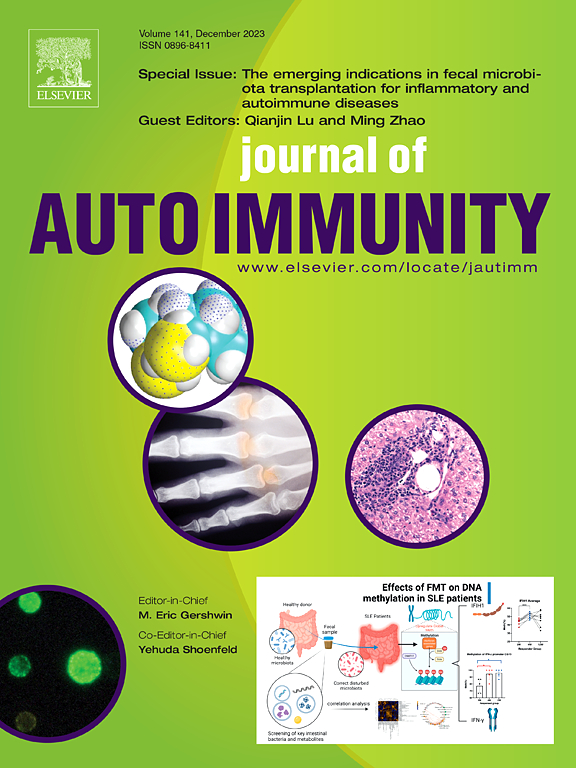排除肉样瘤病替代诊断的框架。
IF 7
1区 医学
Q1 IMMUNOLOGY
引用次数: 0
摘要
肉样瘤病是一种多系统肉芽肿综合征,是由对触发抗原的持续免疫反应引起的。肉样瘤病的诊断没有 "金标准 "检验或算法,因此诊断属于排除性诊断。该病的表现因人而异,无论是受累器官的数量还是各个器官的表现都大不相同。这些特点决定了医护人员在诊断肉样瘤病时必须考虑各种可能的替代诊断,包括各种表现和医学专科(感染、炎症、心脏、神经)。目前基于指南的肉样瘤病诊断建议满足三个标准:1)符合临床表现和/或影像学检查;2)活组织检查显示肉芽肿性炎症(如有可能);3)排除其他病因,但并未就排除其他诊断的标准化策略提供指导。在本综述中,我们总结了肉样瘤病累及肺、眼、皮肤、中枢神经系统、心脏、肝脏和肾脏时最常见的鉴别诊断。然后,我们根据肉样瘤病的检测前概率,提出了一个排除其他诊断的检测框架,该概率被定义为高(典型的检查结果,同时证实肉样瘤病累及其他器官)、中(单一器官的典型检查结果)或低(非典型/检查结果提示其他诊断)。这项工作强调了在肉样瘤病中对替代诊断进行知情和谨慎排除的必要性。本文章由计算机程序翻译,如有差异,请以英文原文为准。
A framework for exclusion of alternative diagnoses in sarcoidosis
Sarcoidosis is a multisystem granulomatous syndrome that arises from a persistent immune response to a triggering antigen(s). There is no “gold standard” test or algorithm for the diagnosis of sarcoidosis, making the diagnosis one of exclusion. The presentation of the disease varies substantially between individuals, in both the number of organs involved, and the manifestations seen in individual organs. These qualities dictate that health care providers diagnosing sarcoidosis must consider a wide range of possible alternative diagnoses, from across a range of presentations and medical specialties (infectious, inflammatory, cardiac, neurologic). Current guideline-based diagnosis of sarcoidosis recommends fulfillment of three criteria: 1) compatible clinical presentation and/or imaging 2) demonstration of granulomatous inflammation by biopsy (when possible) and, 3) exclusion of alternative causes, but do not provide guidance on standardized strategies for exclusion of alternative diagnoses. In this review, we provide a summary of the most common differential diagnoses for sarcoidosis involvement of lung, eye, skin, central nervous system, heart, liver, and kidney. We then propose a framework for testing to exclude alternative diagnoses based on pretest probability of sarcoidosis, defined as high (typical findings with sarcoidosis involvement confirmed in another organ), moderate (typical findings in a single organ), or low (atypical/findings suggesting of an alternative diagnosis). This work highlights the need for informed and careful exclusion of alternative diagnoses in sarcoidosis.
求助全文
通过发布文献求助,成功后即可免费获取论文全文。
去求助
来源期刊

Journal of autoimmunity
医学-免疫学
CiteScore
27.90
自引率
1.60%
发文量
117
审稿时长
17 days
期刊介绍:
The Journal of Autoimmunity serves as the primary publication for research on various facets of autoimmunity. These include topics such as the mechanism of self-recognition, regulation of autoimmune responses, experimental autoimmune diseases, diagnostic tests for autoantibodies, as well as the epidemiology, pathophysiology, and treatment of autoimmune diseases. While the journal covers a wide range of subjects, it emphasizes papers exploring the genetic, molecular biology, and cellular aspects of the field.
The Journal of Translational Autoimmunity, on the other hand, is a subsidiary journal of the Journal of Autoimmunity. It focuses specifically on translating scientific discoveries in autoimmunity into clinical applications and practical solutions. By highlighting research that bridges the gap between basic science and clinical practice, the Journal of Translational Autoimmunity aims to advance the understanding and treatment of autoimmune diseases.
 求助内容:
求助内容: 应助结果提醒方式:
应助结果提醒方式:


